Presentation slides [PDF] - Joint Steering Committee for ...
Presentation slides [PDF] - Joint Steering Committee for ...
Presentation slides [PDF] - Joint Steering Committee for ...
You also want an ePaper? Increase the reach of your titles
YUMPU automatically turns print PDFs into web optimized ePapers that Google loves.
(Resource Description and Access)The development of a newinternational cataloging codeModena, ItalyDecember 13, 2007Dr. Barbara B. Tillett,Library of Congress
Topics today• Foundations <strong>for</strong> RDA• What is RDA and why a new standard?• RDA goals, structure, and content
Anglo-American Tradition18411876188918911904190819411949
IFLA Influence on CataloguingCodes• 1961 – IFLA’s“Paris Principles”
Anglo-American Tradition184118761902190419061908194119491967
• 1969 – IFLA’s ISBDsMore IFLA Influence• International Standard BibliographicDescription• 2007Consolidateded.
• AACR2• 1978• 1988• 1998• 2002
FRBR• IFLA’s FunctionalRequirements <strong>for</strong>Bibliographic Records(FRBR)• User tasks• Find• Identify• Select• Obtain• Entities, Relationships,Attributes• Mandatory elements <strong>for</strong> anational level bibliographicrecord
Paris Principles (1961)• Scope• Function• Structure of theCatalogue• Kinds of Entry• Use of MultipleEntries• Choice of Uni<strong>for</strong>mHeading• Single PersonalAuthor• Entry underCorporate Bodies• Multiple Authorship• Works Enteredunder Title, Uni<strong>for</strong>mHeadings <strong>for</strong> Works,etc.• Entry Word <strong>for</strong>Personal Names
Update Paris Principles• IFLA Meeting ofExperts on anInternationalCataloguing Code• December 2003+• IME ICC draftStatement ofInternationalCataloguingPrinciples–IME ICC
IME ICCGoals & Objectives• Goal• Increase the ability to share cataloguingworldwide by• Promoting standards• Objectives• Develop “Statement of InternationalCataloguing Principles”• See if rules/practices can get closer together• Make recommendations <strong>for</strong> an InternationalCataloguing Code
IME ICC Regional Meetings• IME ICC1 – Europe/Anglo-American (2003)http://www.d-nb.de/standardisierung/afs/imeicc_index.htm• IME ICC2 – Latin America-Caribbean (2004)• IME ICC3 – Middle East (2005)• IME ICC4 – Asia (2006)http://www.loc.gov/imeicc2http://www.loc.gov/loc/ifla/imeicc/http://www.nl.go.kr/icc/icc/main.php
IME ICC5• 2007 August 14-15 subSaharanAfrica• Hosted by theNational Library of South Africa,Pretoria, South Africahttp://www.imeicc5.com
New standard: why?• Align with conceptual models (FRBR, FRAD)to build well-<strong>for</strong>med metadata• Encourage use as a content standard <strong>for</strong>metadata schema• Encourage application of FRBR/FRAD• Encourage international applicability• Address current problems• Provide more consistency• Principle-based (IME ICC)• To build cataloger’s judgment
New Cataloging Environment• Wide range of in<strong>for</strong>mation carriers: widerdepth & complexity of content• Metadata (bibliographic in<strong>for</strong>mation) createdby a wider range of personnel in and outsidelibraries; some using new metadata schemas(Dublin Core, etc.)• Descriptive data in digital <strong>for</strong>m (ONIX, etc.)
GOALS: RDA will be …• A new standard <strong>for</strong> resource descriptionand access• Designed <strong>for</strong> the digital environment• Web-based product• paper also available• Description and access of all digital and analogresources• Resulting records usable in the digitalenvironment (Internet, Web OPACs, etc.)
RDA will be …• “A multinational content standardproviding bibliographic description andaccess <strong>for</strong> the variety of media and <strong>for</strong>matscollected by libraries today”• Designed to be used in all languagecommunities• Intend to removeEnglish-bias
Content vs. display• RDA will be a content standard --not adisplay or encoding standard• Independent of the encoding communication<strong>for</strong>mat (e.g., MARC 21, MODS, Dublin Core)• Independent of display <strong>for</strong>mat (e.g., OPAClabels, ISBD)• International Standard BibliographicDescription (ISBD) display in<strong>for</strong>mation inAppendix to RDA• RDA-created records can be displayed in anISBD display, if desired
RDA will …• Support FRBR user tasks• Find, identify, select, obtain• Enable users of library catalogs, etc., tofind and use resources appropriate totheir in<strong>for</strong>mation needs
Who develops and<strong>Committee</strong>ofPrincipalssupports RDA?AACR FundTrustees/Publishers<strong>Joint</strong> <strong>Steering</strong><strong>Committee</strong>ALACC:DAACOC BL CCC CILIP LC
JSC and Project Management Team
• Process of creating RDA• Editor drafts chapters• JSC reviews chapters• Editor revises chaptersCreating RDA• JSC constituencies (and others) reviewchapters• JSC considers comments and requestschanges to text by the Editor
Web ToolData Dictionary• Data elements and sub-elements• Required or optional• RDA/DC/IEEE/LOM/Semantic Web• “Data Modeling Meeting” - London 2007
RDA Oct. 2007 Structure• General introduction• Attributes• Relationships• Appendices• Capitalization, Abbreviations, Initial articles• <strong>Presentation</strong> (ISBD display, etc.)• Controlled lists• Glossary• Index
New TerminologyAACR2 termsHeadingAuthorized headingMain EntryAdded EntryAuthority controlUni<strong>for</strong>m titleRDA termsAccess pointPreferred access pointAccess point/creator of workAccess pointAccess point controlPreferred titleName of the work (to includename of creator whenapplicable)
New elements• Media, Carrier, and Content Types toreplace GMDs• Other examples:• File characteristics <strong>for</strong> digital materials• Video <strong>for</strong>mat characteristics• Custodial in<strong>for</strong>mation <strong>for</strong> archival resources• Braille characteristics
Transcription• Importance of transcription of data toidentify the resource varies• Rare books – very important!• Digital materials – maybe not as important• “Take what you see”• Correction of inaccuracies elsewhere• Facilitating automated data capture
AppendicesA - CapitalizationB - AbbreviationsC - Initial articlesD - Record syntaxes <strong>for</strong> descriptive data• ISBD, MARC 21 Bibliographic <strong>for</strong>mat displaysE - Record syntaxes <strong>for</strong> access point control data• MARC 21 Authority <strong>for</strong>mat displays• Appendices <strong>for</strong> controlled vocabulary lists• Roles, relationships designations, types of carriers,types of content, etc.
Making decisions …• Required data elements + which others?• Which alternatives and options?• Who decides how to apply RDA?• National libraries• Other governing bodies: OCLC, theProgram <strong>for</strong> Cooperative Cataloging• Individual institutions
Customizing RDA Web Tool• Instructions will be coded by type ofcontent, mode of issuance, etc.:• Can create a customized version of theWeb-based RDA to see only theinstructions you need or want to see• Cartographic instructions• Serial instructions• Etc.
Questions and Answers• FAQ (“Frequently Asked Questions”) onadopting RDA and other topics available onthe JSC Web site:http://www.collectionscanada.ca/jsc/rda.html
Retrospective catalog maintenance?• Intend <strong>for</strong> RDA records to be compatible• Need <strong>for</strong> retrospective adjustments whenintegrating RDA and AACR2 records will beminimal, if at all
Draft Reviews• Dec. 2007-Mar. 2008: “Access PointControl”• July-Sept. 2008: Complete draft of RDA• August 2008: Web RDA Prototype demoat IFLA?• Early 2009: First release of RDA
Commenting on RDA Drafts• RDA drafts & documents available at:http://www.collectionscanada.ca/jsc/rda.html• In<strong>for</strong>mal discussion: subscribe to RDA-L(link on page above)• Formal comments: send to Chair of JSC,Deirdre Kiorgaard, dkiorgaa@nla.gov.au
Training <strong>for</strong> RDA• Catalogers will need some training in RDA• Orientation and background on the underlyingconceptual models and principles• Training on rules that have changed betweenAACR2 and RDA• Groups that provide training are beginning tomake plans• Online product will assist with learning
RDA Products• Online (Web Tool) product first:• Different pricing structures• Additional <strong>for</strong>mats: co-publisherswant in<strong>for</strong>mation from you• Focus groups at ALA Annual Conferencein June 2007• Questions also to be posted online <strong>for</strong>your responses
Summary• An international cataloging code• Collaborative ef<strong>for</strong>t• Resulting records <strong>for</strong> use in Webenvironment• 2009


![Presentation slides [PDF] - Joint Steering Committee for ...](https://img.yumpu.com/41621230/1/500x640/presentation-slides-pdf-joint-steering-committee-for-.jpg)

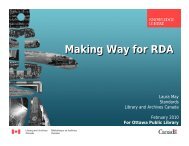
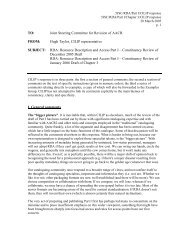
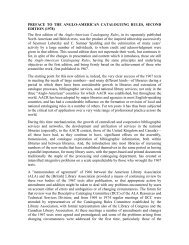
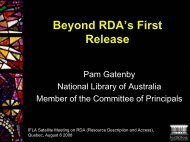

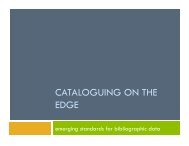


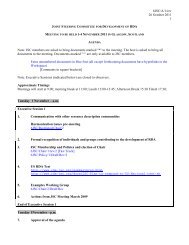
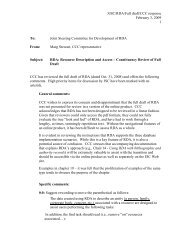
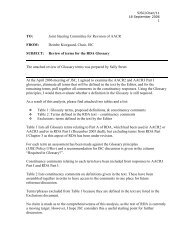
![Presentation slides [PDF] - Joint Steering Committee for ...](https://img.yumpu.com/35256207/1/190x143/presentation-slides-pdf-joint-steering-committee-for-.jpg?quality=85)
